Evaluating Research Methodologies: Employee Motivation Study
VerifiedAdded on 2023/06/15
|7
|921
|306
Essay
AI Summary
This essay provides an analysis of research methodologies concerning employee motivation, comparing quantitative and mixed-method approaches. It reviews two specific articles, one focusing on a self-administered questionnaire (SAQ) for quantifying employee motivation and the other a mixed-methods dissertation on worker motivation within a manufacturing organization. The essay argues that mixed-method research is preferable due to its comprehensive nature, incorporating both qualitative and quantitative data, detailed theoretical analysis, and the possibility of triangulation. The rationale behind this preference includes the ability of mixed methods to provide a thorough and synchronized evaluation, allowing for a more precise understanding of the subject matter through different vantage points and strategies. The essay concludes by highlighting the advantages of mixed methods, such as triangulation, complementarity, and development, in enhancing the depth and validity of research findings. Desklib provides access to similar solved assignments and study tools for students.

Running head: RESEARCH METHODOLOGIES REGARDING EMPLOYEE MOTIVATION
RESEARCH METHODOLOGIES REGARDING EMPLOYEE MOTIVATION
Name of the Student
Name of the University
Author Note
RESEARCH METHODOLOGIES REGARDING EMPLOYEE MOTIVATION
Name of the Student
Name of the University
Author Note
Paraphrase This Document
Need a fresh take? Get an instant paraphrase of this document with our AI Paraphraser

1RESEARCH METHODOLOGIES REGARDING EMPLOYEE MOTIVATION
Table of Contents
Introduction......................................................................................................................................2
Summary of the articles...................................................................................................................2
Preferred choice of methodology.....................................................................................................4
Rationale behind the preferred methodology..................................................................................4
References........................................................................................................................................6
Table of Contents
Introduction......................................................................................................................................2
Summary of the articles...................................................................................................................2
Preferred choice of methodology.....................................................................................................4
Rationale behind the preferred methodology..................................................................................4
References........................................................................................................................................6
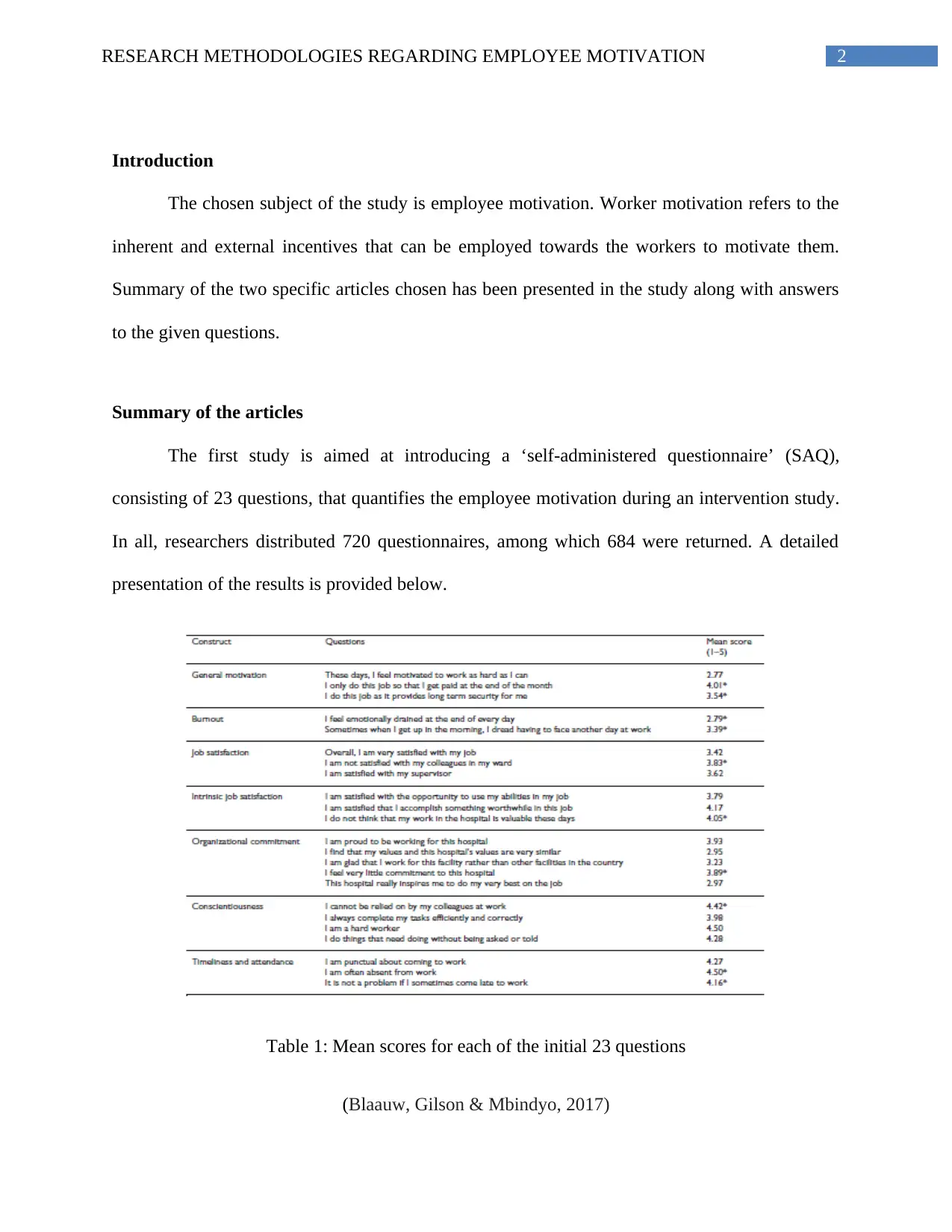
2RESEARCH METHODOLOGIES REGARDING EMPLOYEE MOTIVATION
Introduction
The chosen subject of the study is employee motivation. Worker motivation refers to the
inherent and external incentives that can be employed towards the workers to motivate them.
Summary of the two specific articles chosen has been presented in the study along with answers
to the given questions.
Summary of the articles
The first study is aimed at introducing a ‘self-administered questionnaire’ (SAQ),
consisting of 23 questions, that quantifies the employee motivation during an intervention study.
In all, researchers distributed 720 questionnaires, among which 684 were returned. A detailed
presentation of the results is provided below.
Table 1: Mean scores for each of the initial 23 questions
(Blaauw, Gilson & Mbindyo, 2017)
Introduction
The chosen subject of the study is employee motivation. Worker motivation refers to the
inherent and external incentives that can be employed towards the workers to motivate them.
Summary of the two specific articles chosen has been presented in the study along with answers
to the given questions.
Summary of the articles
The first study is aimed at introducing a ‘self-administered questionnaire’ (SAQ),
consisting of 23 questions, that quantifies the employee motivation during an intervention study.
In all, researchers distributed 720 questionnaires, among which 684 were returned. A detailed
presentation of the results is provided below.
Table 1: Mean scores for each of the initial 23 questions
(Blaauw, Gilson & Mbindyo, 2017)
⊘ This is a preview!⊘
Do you want full access?
Subscribe today to unlock all pages.

Trusted by 1+ million students worldwide
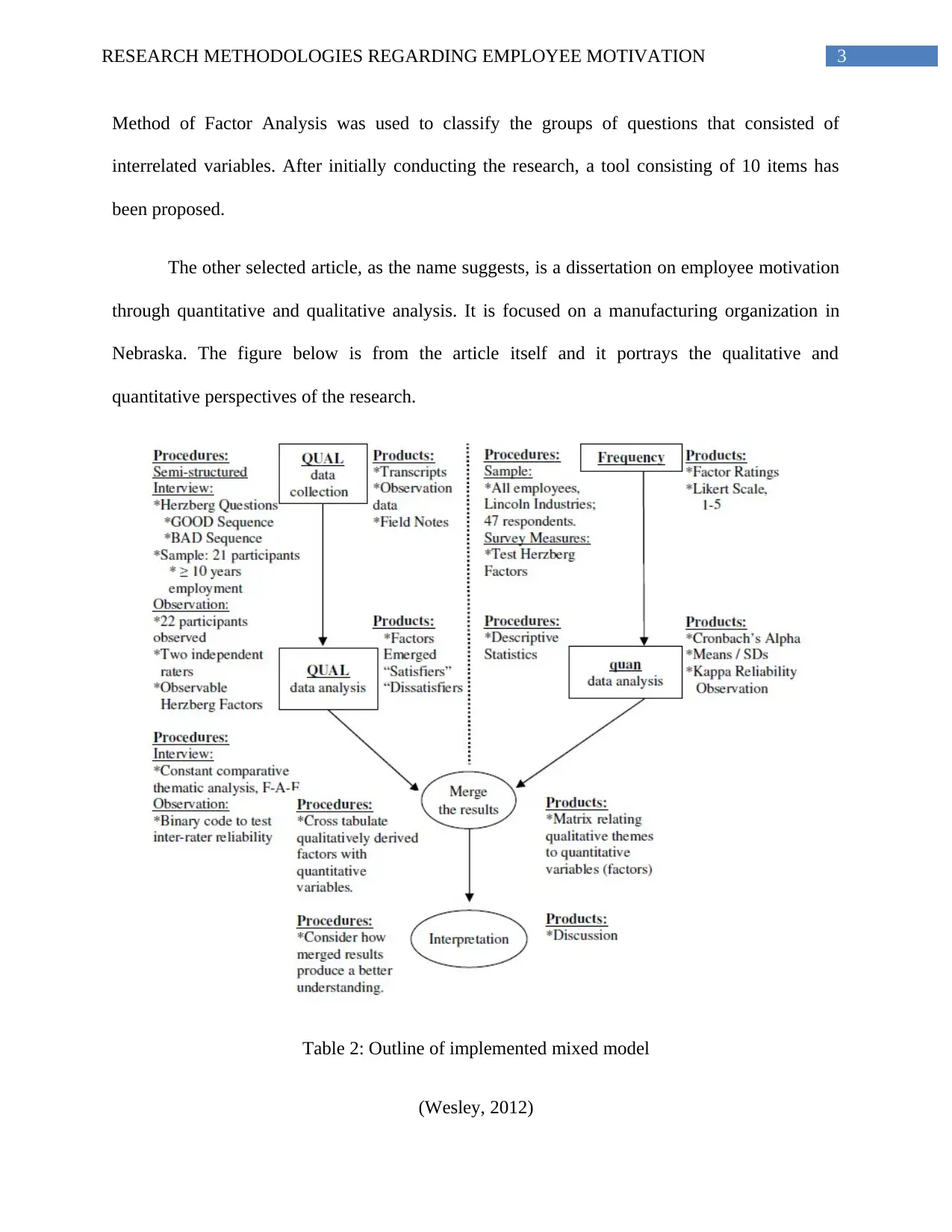
3RESEARCH METHODOLOGIES REGARDING EMPLOYEE MOTIVATION
Method of Factor Analysis was used to classify the groups of questions that consisted of
interrelated variables. After initially conducting the research, a tool consisting of 10 items has
been proposed.
The other selected article, as the name suggests, is a dissertation on employee motivation
through quantitative and qualitative analysis. It is focused on a manufacturing organization in
Nebraska. The figure below is from the article itself and it portrays the qualitative and
quantitative perspectives of the research.
Table 2: Outline of implemented mixed model
(Wesley, 2012)
Method of Factor Analysis was used to classify the groups of questions that consisted of
interrelated variables. After initially conducting the research, a tool consisting of 10 items has
been proposed.
The other selected article, as the name suggests, is a dissertation on employee motivation
through quantitative and qualitative analysis. It is focused on a manufacturing organization in
Nebraska. The figure below is from the article itself and it portrays the qualitative and
quantitative perspectives of the research.
Table 2: Outline of implemented mixed model
(Wesley, 2012)
Paraphrase This Document
Need a fresh take? Get an instant paraphrase of this document with our AI Paraphraser
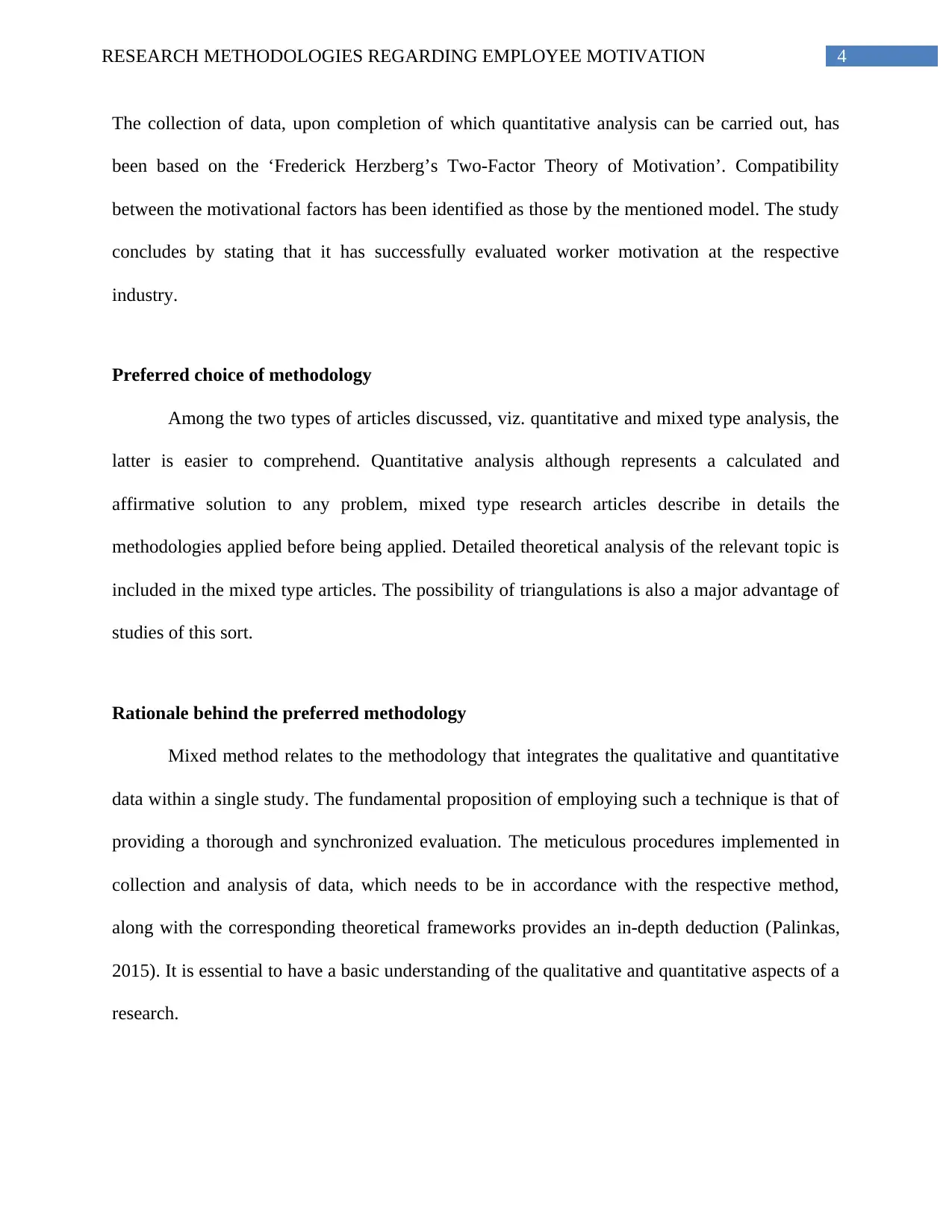
4RESEARCH METHODOLOGIES REGARDING EMPLOYEE MOTIVATION
The collection of data, upon completion of which quantitative analysis can be carried out, has
been based on the ‘Frederick Herzberg’s Two-Factor Theory of Motivation’. Compatibility
between the motivational factors has been identified as those by the mentioned model. The study
concludes by stating that it has successfully evaluated worker motivation at the respective
industry.
Preferred choice of methodology
Among the two types of articles discussed, viz. quantitative and mixed type analysis, the
latter is easier to comprehend. Quantitative analysis although represents a calculated and
affirmative solution to any problem, mixed type research articles describe in details the
methodologies applied before being applied. Detailed theoretical analysis of the relevant topic is
included in the mixed type articles. The possibility of triangulations is also a major advantage of
studies of this sort.
Rationale behind the preferred methodology
Mixed method relates to the methodology that integrates the qualitative and quantitative
data within a single study. The fundamental proposition of employing such a technique is that of
providing a thorough and synchronized evaluation. The meticulous procedures implemented in
collection and analysis of data, which needs to be in accordance with the respective method,
along with the corresponding theoretical frameworks provides an in-depth deduction (Palinkas,
2015). It is essential to have a basic understanding of the qualitative and quantitative aspects of a
research.
The collection of data, upon completion of which quantitative analysis can be carried out, has
been based on the ‘Frederick Herzberg’s Two-Factor Theory of Motivation’. Compatibility
between the motivational factors has been identified as those by the mentioned model. The study
concludes by stating that it has successfully evaluated worker motivation at the respective
industry.
Preferred choice of methodology
Among the two types of articles discussed, viz. quantitative and mixed type analysis, the
latter is easier to comprehend. Quantitative analysis although represents a calculated and
affirmative solution to any problem, mixed type research articles describe in details the
methodologies applied before being applied. Detailed theoretical analysis of the relevant topic is
included in the mixed type articles. The possibility of triangulations is also a major advantage of
studies of this sort.
Rationale behind the preferred methodology
Mixed method relates to the methodology that integrates the qualitative and quantitative
data within a single study. The fundamental proposition of employing such a technique is that of
providing a thorough and synchronized evaluation. The meticulous procedures implemented in
collection and analysis of data, which needs to be in accordance with the respective method,
along with the corresponding theoretical frameworks provides an in-depth deduction (Palinkas,
2015). It is essential to have a basic understanding of the qualitative and quantitative aspects of a
research.
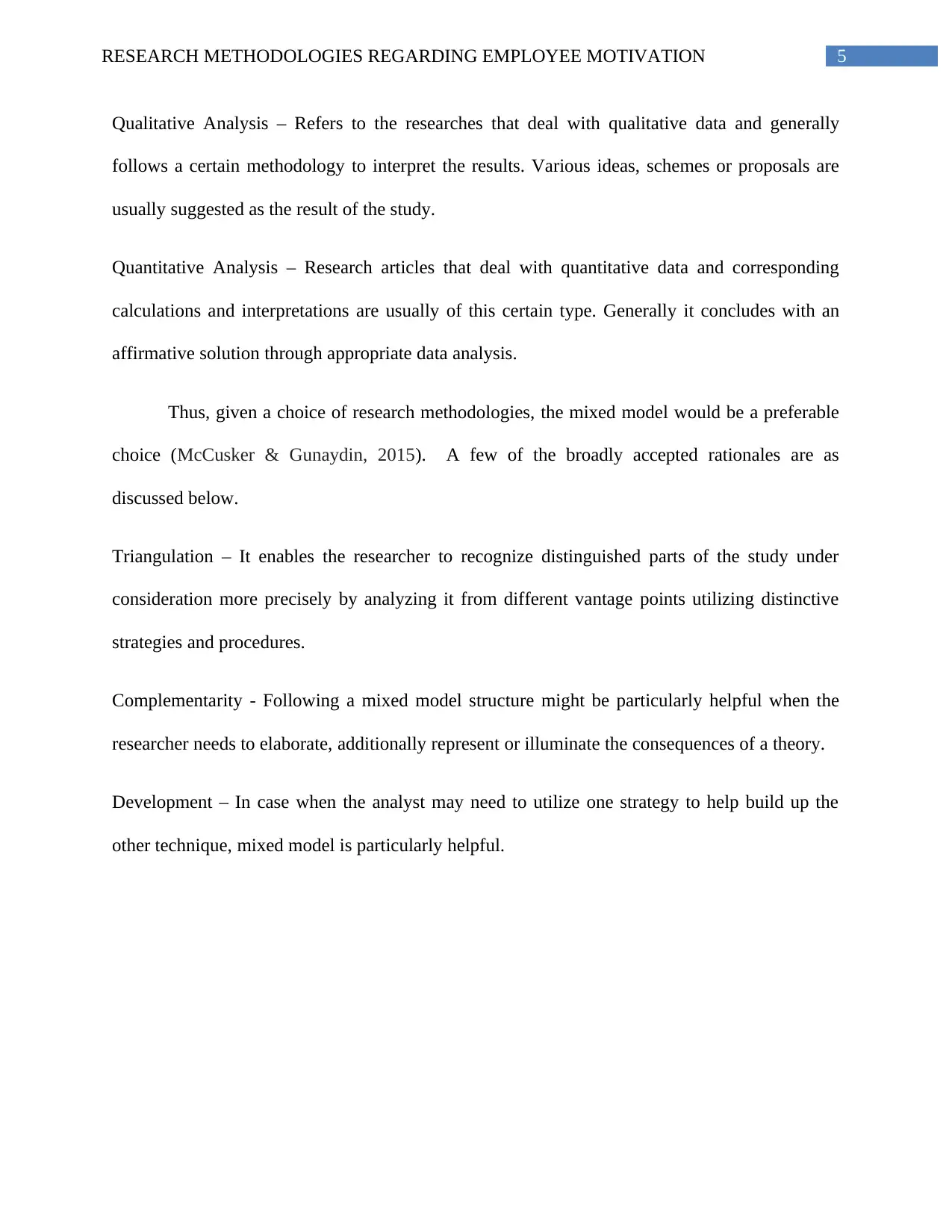
5RESEARCH METHODOLOGIES REGARDING EMPLOYEE MOTIVATION
Qualitative Analysis – Refers to the researches that deal with qualitative data and generally
follows a certain methodology to interpret the results. Various ideas, schemes or proposals are
usually suggested as the result of the study.
Quantitative Analysis – Research articles that deal with quantitative data and corresponding
calculations and interpretations are usually of this certain type. Generally it concludes with an
affirmative solution through appropriate data analysis.
Thus, given a choice of research methodologies, the mixed model would be a preferable
choice (McCusker & Gunaydin, 2015). A few of the broadly accepted rationales are as
discussed below.
Triangulation – It enables the researcher to recognize distinguished parts of the study under
consideration more precisely by analyzing it from different vantage points utilizing distinctive
strategies and procedures.
Complementarity - Following a mixed model structure might be particularly helpful when the
researcher needs to elaborate, additionally represent or illuminate the consequences of a theory.
Development – In case when the analyst may need to utilize one strategy to help build up the
other technique, mixed model is particularly helpful.
Qualitative Analysis – Refers to the researches that deal with qualitative data and generally
follows a certain methodology to interpret the results. Various ideas, schemes or proposals are
usually suggested as the result of the study.
Quantitative Analysis – Research articles that deal with quantitative data and corresponding
calculations and interpretations are usually of this certain type. Generally it concludes with an
affirmative solution through appropriate data analysis.
Thus, given a choice of research methodologies, the mixed model would be a preferable
choice (McCusker & Gunaydin, 2015). A few of the broadly accepted rationales are as
discussed below.
Triangulation – It enables the researcher to recognize distinguished parts of the study under
consideration more precisely by analyzing it from different vantage points utilizing distinctive
strategies and procedures.
Complementarity - Following a mixed model structure might be particularly helpful when the
researcher needs to elaborate, additionally represent or illuminate the consequences of a theory.
Development – In case when the analyst may need to utilize one strategy to help build up the
other technique, mixed model is particularly helpful.
⊘ This is a preview!⊘
Do you want full access?
Subscribe today to unlock all pages.

Trusted by 1+ million students worldwide
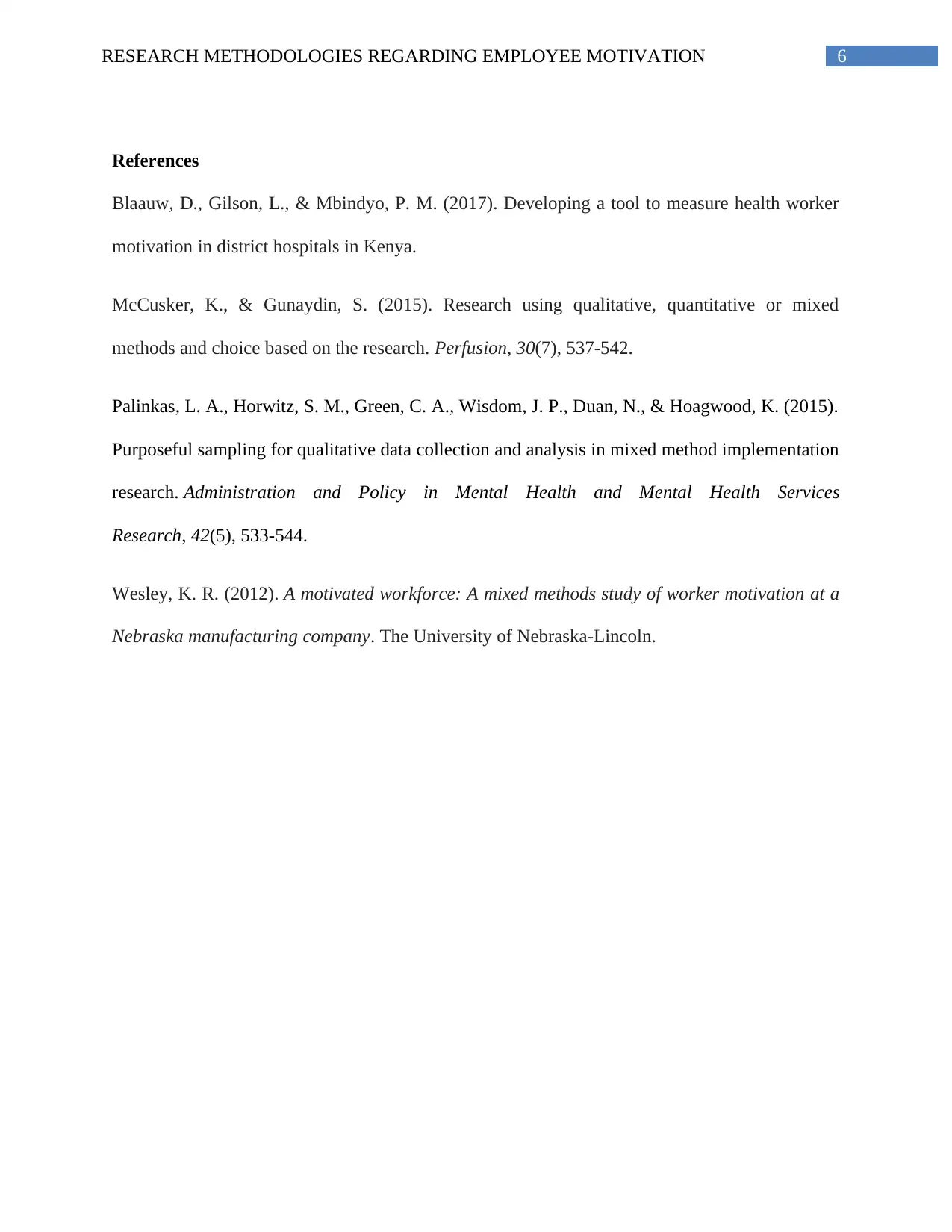
6RESEARCH METHODOLOGIES REGARDING EMPLOYEE MOTIVATION
References
Blaauw, D., Gilson, L., & Mbindyo, P. M. (2017). Developing a tool to measure health worker
motivation in district hospitals in Kenya.
McCusker, K., & Gunaydin, S. (2015). Research using qualitative, quantitative or mixed
methods and choice based on the research. Perfusion, 30(7), 537-542.
Palinkas, L. A., Horwitz, S. M., Green, C. A., Wisdom, J. P., Duan, N., & Hoagwood, K. (2015).
Purposeful sampling for qualitative data collection and analysis in mixed method implementation
research. Administration and Policy in Mental Health and Mental Health Services
Research, 42(5), 533-544.
Wesley, K. R. (2012). A motivated workforce: A mixed methods study of worker motivation at a
Nebraska manufacturing company. The University of Nebraska-Lincoln.
References
Blaauw, D., Gilson, L., & Mbindyo, P. M. (2017). Developing a tool to measure health worker
motivation in district hospitals in Kenya.
McCusker, K., & Gunaydin, S. (2015). Research using qualitative, quantitative or mixed
methods and choice based on the research. Perfusion, 30(7), 537-542.
Palinkas, L. A., Horwitz, S. M., Green, C. A., Wisdom, J. P., Duan, N., & Hoagwood, K. (2015).
Purposeful sampling for qualitative data collection and analysis in mixed method implementation
research. Administration and Policy in Mental Health and Mental Health Services
Research, 42(5), 533-544.
Wesley, K. R. (2012). A motivated workforce: A mixed methods study of worker motivation at a
Nebraska manufacturing company. The University of Nebraska-Lincoln.
1 out of 7
Related Documents
Your All-in-One AI-Powered Toolkit for Academic Success.
+13062052269
info@desklib.com
Available 24*7 on WhatsApp / Email
![[object Object]](/_next/static/media/star-bottom.7253800d.svg)
Unlock your academic potential
Copyright © 2020–2025 A2Z Services. All Rights Reserved. Developed and managed by ZUCOL.





